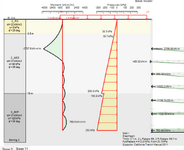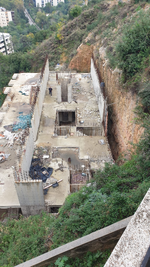A client is asking for the lateral earth pressure which his building will be subject to, and that facing a open cut excavation of 27 m. The soil is very stiff silty sand and/or sandstone. The excavation is standing undisturbed since more than 10 years, and the building was started at the time then kept unfinished. Now the client is intending to continue working on it.
Plugging the values into Excel, and using Lateral Earth Pressure at rest, I am having very high values. And the values given by software are even higher. (Plz see below). To alleviate the pressure the pressure on the walls the client is proposing to link the building slab directly to the cliff. Hence the forces on the slab in the picture below.
Since the values seem too high, I am questioning the use of the lateral earth pressure at rest in this case. In the formula of Ko, the cohesion is not used since the soil is not mobilised. But the soil has already moved ?!


Plugging the values into Excel, and using Lateral Earth Pressure at rest, I am having very high values. And the values given by software are even higher. (Plz see below). To alleviate the pressure the pressure on the walls the client is proposing to link the building slab directly to the cliff. Hence the forces on the slab in the picture below.
Since the values seem too high, I am questioning the use of the lateral earth pressure at rest in this case. In the formula of Ko, the cohesion is not used since the soil is not mobilised. But the soil has already moved ?!


